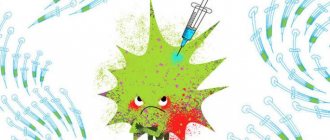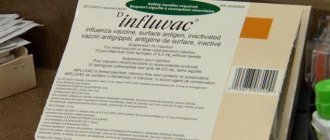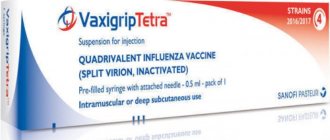Seasonal influenza is an annual vaccine designed to protect against influenza.
Flu shots are recommended for all ages 6 months and older.
Influenza can be a very serious illness, especially in young children, adults age 65 and older, those with underlying health conditions, and pregnant women.
Getting a flu shot is the best way to protect yourself and your family.
Strains of the flu virus are constantly changing, so a new flu vaccine is produced every year. Scientists are creating a vaccine ahead of the 2017-2018 season by predicting which flu strains are likely to be most common.
Because the flu virus changes its genetic makeup frequently, the vaccine needs to be reformulated, which is one reason people should get a flu shot every year.
What types of flu are there?
Influenza strains protect against three or four strains of the influenza virus. Trivalent influenza vaccines protect against two strains of influenza A—H1N1 and H3N2—and one strain of influenza B virus. Quadrivalent influenza vaccines, first offered during the 2013-2014 flu season, protect against the same strains as the trivalent vaccine, plus additional influenza B strain.
In addition to the standard needle-stick flu vaccine, flu shots are available in several different forms, including a high-dose version for those 65 years of age and older, a low-dose version (intradermal flu vaccine), and a nasal spray that approved for healthy people aged 2 to 49 years.
There is also a needle-less syringe with a so-called jet injector, which uses a high-pressure stream of liquid to inject the vaccine. It is approved for adults 18 to 64 years of age.

ACIP CDC has issued recommendations for influenza vaccination for the 2017/2018 season
Vaccines
ACIP CDC does not recommend the use of live attenuated influenza vaccine given its low effectiveness against A(H1N1) pdm09 viruses in the 2013/2014 and 2015/2016 seasons.
Trivalent and quadrivalent inactivated and recombinant influenza vaccines will be available for vaccination.
Deadlines and general principles
The optimal time for vaccination cannot be predicted with certainty, but it is recommended that the vaccine be completed by the end of October.
Children aged 6 months to 8 years who require 2 doses of the vaccine should receive the first as soon as possible. The second dose is scheduled for no earlier than 4 weeks and must be completed by the end of October.
There is evidence that early vaccination (eg in July or August) may be associated with suboptimal immunity towards the end of the epidemiological season. This pattern is especially pronounced in the elderly. However, revaccination at the end of the season is not recommended.
Influenza vaccine should be offered as long as influenza viruses circulate and a vaccine is available.
Number of doses
Children 6 months to 8 years of age require 2 doses of influenza vaccine during the first vaccination season. The interval between two doses should be at least 4 weeks. If a child received at least 2 doses before July 1, 2021, only 1 dose of vaccine is required for the current season.
For seniors aged 65 years and older, a vaccine containing a standard or high dose of antigens must be administered.
Special populations
In immunocompromised individuals, the immune response to live or inactivated vaccines may be reduced. For this reason, the timing of vaccination can be revised, and the period of administration chosen is the period before or after an immunocompromising intervention.
In case of development of Guillain-Barré syndrome within 6 weeks after the previous administration, vaccination is usually not indicated. Alternatively, clinicians may consider antiviral chemoprophylaxis in these individuals. However, sometimes the benefits of vaccination may outweigh the risks for individuals with a history of Guillain-Barré syndrome. For example, in cases where there is a high risk of serious complications from the flu.
Recommended Groups
The CDC recommends vaccination for everyone over 6 months of age who has no contraindications.
However, vaccination is especially important for people at increased risk of complications:
- children aged 6 to 59 months;
- adults aged 50 years and older;
- adults and children with chronic pulmonary pathology (including asthma), cardiovascular (except for isolated hypertension), renal, hepatic, neurological, hematological pathology or metabolic disorders (including diabetes mellitus);
- immunodeficiency, including immunosuppression caused by drugs or HIV infection;
- pregnant women or those who will be pregnant during flu season;
- children and adolescents (6 months to 18 years) receiving medications containing aspirin or salicylate who are at high risk of developing Reye's syndrome after infection with the influenza virus;
- persons living in nursing homes and other long-term care facilities;
- obese persons (BMI ≥ 40).
In addition, preventive influenza vaccinations are required for health care workers in hospitals, outpatient settings, emergency responders, nursing and long-term care homes, students who have contact with patients and residents, educators and caregivers.
Flu vaccines for the 2017-2018 season
The composition of the 2017-2018 flu will be slightly different from last season's flu. Specifically, this season's flu will have a different strain of the H1N1 virus compared to last season's flu shot. Trivalent influenza in 2017-2018 will contain the following strains of the influenza virus:
- A/Michigan/45/2015 (H1N1) pdm09-like virus. This is a component of H1N1 that is different from last year's flu.
- A/Hong Kong/4801/2014 (H3N2)-like virus. This is a component of H3N2 that is similar to last year's flu.
- B/Brisbane/60/2008-like (B/Victoria lineage) is a component of the influenza B virus strain that is similar to last year's jab.
The 2017-2018 quadrivalent vaccine will also contain a second strain of influenza B virus, called B/Phuket/3073/2013 virus (B/Yamagata lineage), which was also included in last season's quadrivalent vaccine.
Just like last flu season, the flu nasal spray is not recommended for anyone during the 2017-2018 flu season. For the second year in a row, nasal spray has been removed from the list of recommended types of flu vaccines. This decision was based on data showing that the nasal spray was not very effective in preventing influenza from 2013 to 2021. Eliminating nasal spray use during the 2016-2017 flu season did not affect the overall percentage of people who received a flu shot that season. It is unclear whether this recommendation will change in future seasons.
Pregnant women can receive any of the flu vaccines recommended for their age group, except the nasal spray (also called live attenuated influenza vaccine or LAIV). This means that pregnant women can receive either an "inactivated" (killed) flu vaccine or a "recombinant" vaccine, which is made without the use of chicken eggs and can be given to people with an egg allergy. Previously, there were statements that pregnant women should receive “inactivated” ones, but there was no mention of the use of recombinant vaccines.
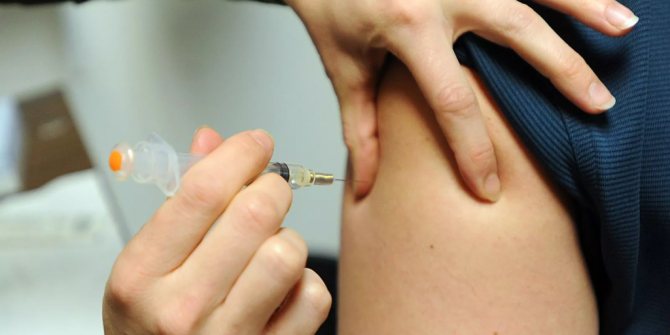
Flu vaccinations for the 2019–2020 season
WHO reports that in the 2019-2020 season, mainly influenza B is expected, as well as influenza A - H3N2 and H1N1. The WHO recommended the first three viral strains to be included in trivalent influenza vaccines.
Population groups for whom vaccination is recommended:
Annual influenza immunization is recommended for all individuals 6 months of age and older who have no contraindications.
Vaccination dates:
Vaccination efforts should continue throughout the influenza season. It is optimal to administer immunization before the onset of influenza activity in the community. However, because the timing of the onset, peak, and decline of influenza activity varies, it is impossible to accurately predict the ideal timing.
Children aged six months to 8 years who require two doses of the vaccine should be given the first dose at the earliest opportunity so that they can receive the second dose (should be given at least 4 weeks later) by the end of October.
Recommendations for high-risk groups
For people at increased risk of severe illness or complications from influenza, vaccination is especially important.
These include:
- children from 6 to 59 months;
- adults 50 years and older;
- adults and children with chronic pulmonary pathology (including asthma), cardiovascular (except for isolated hypertension), renal, hepatic, neurological, hematological diseases or metabolic disorders (including diabetes mellitus);
- persons who are immunocompromised for any reason, including immunosuppression caused by drugs or HIV infection;
- those who are pregnant or who will be pregnant during flu season;
- children and adolescents (6 months to 18 years) receiving medications containing aspirin or salicylate who are at high risk of developing Reye's syndrome after infection with the influenza virus;
- persons living in nursing homes and other long-term care facilities;
- American Indians and Alaska Natives;
- obese persons (BMI ≥ 40).
Moreover, immunization is recommended for people who live with or come into direct contact with people at high risk (for example, health care workers or non-medical staff of health care facilities).
Updates on flu vaccine strains
In the 2019–2020 season. trivalent influenza vaccines will contain (WHO):
A/Brisbane/02/2018 (H1N1) pdm09-like virus;
A/Kansas/14/2017 (H3N2)-like virus;
B/Colorado/06/2017 (line B/Victoria/2/87).
In addition, quadrivalent vaccines will contain virus type B/Phuket/3073/2013 (lineage B/Yamagata/16/88).
At the Harmony of Health Polyclinic you can be vaccinated with the following vaccines:
1. "Ultrix" - a vaccine against influenza - is a mixture of highly purified protective surface and internal antigens of influenza viruses type A (H1N1 and H3N2) and type B.
After vaccination, antibodies appear within 8–12 days. Immunity lasts up to 12 months. The high effectiveness of the vaccine is ensured by the presence of both surface and internal antigens of the influenza virus.
2. “Grippol plus” is a trivalent inactivated polymer-subunit influenza vaccine.
The first Russian anti-influenza vaccine that does not contain preservatives, in individual syringes.
It is used for all categories of the population, including risk groups: children over 6 months, pregnant women, elderly people, people with chronic somatic diseases, allergic diseases and immunodeficiency conditions.
Over the 10 years of use of the Grippol Plus vaccine in the Russian Federation, > 150 million doses have been used for mass immunization of the population.
The vaccine contains purified antigens of current influenza virus strains recommended by WHO for the current epidemic season. One dose of Grippol® plus contains 5 mcg of hemagglutinin for each of the current strains of influenza virus subtypes A (H1N1 and H3N2) and B, as well as 500 mcg of the adjuvant Polyoxidonium.
An adjuvant is a substance used in combination with a specific antigen that provides a more pronounced immune response than the antigen itself.
Polyoxidonium in the vaccine works in several directions:
- Allows you to reduce the number of antigens, providing a pronounced and long-lasting immune response to vaccination.
- Increases the speed of the immune response.
- Strengthens the immune response in immunologically immature individuals.
- Reduces the protein load on the body and increases the safety of the vaccine.
3. “Ultrix quadri (“Fort”)”
The latest generation inactivated split vaccine includes four current strains of influenza viruses instead of three - A (H1N1), A (H3N2) and two strains of group B influenza viruses. In accordance with the recommendations of the World Health Organization, the new drug contains 15 mcg of hemagglutinin (antigen) each strain in one dose - only 60 μg of antigen. The vaccine is safe, significantly reduces the risk of illness and promotes the formation of lasting immunity.
"Ultrix Quadri" is produced using full-cycle technology in compliance with GMP standards in the Ryazan region.
Quadrivalent vaccines protect against infection more effectively , as they eliminate possible risks associated with the emergence and circulation of the Victorian and Yamagata lines of group B influenza viruses. As of July 2021, about 70% of vaccines used in the United States are quadrivalent, in Japan their share reaches 100 %
The vaccine forms high specific immunity against influenza types A and B. After vaccination, antibodies appear within 8-12 days, immunity lasts up to 12 months.
Indications for use are active annual preventive immunization against seasonal influenza in people aged 18 to 60 years.
Vaccination is carried out annually in the autumn-winter period. Vaccination is possible at the beginning of an epidemic rise in the incidence of influenza. The vaccine is administered intramuscularly in a dose of 0.5 ml once in the area of the deltoid muscle (the upper third of the outer surface of the shoulder).
The vaccine is especially indicated:
- Persons at high risk of illness and complications in case of influenza: - persons who often suffer from acute respiratory viral infections; - persons suffering from chronic somatic diseases, including diseases and malformations of the cardiovascular, respiratory and central nervous systems, chronic kidney diseases, metabolic diseases, diabetes mellitus, chronic anemia, allergic diseases (except allergies to chicken proteins), congenital or acquired immunodeficiency, including infection with the human immunodeficiency virus.
- Persons who, due to the nature of their educational or professional activities, have a high risk of contracting the flu or infecting others with it: - employees of medical and educational institutions, transport, communal and social spheres, police, military personnel, etc.
What are the contraindications to vaccination:
! Absolute - allergies to chicken protein and other vaccines. As well as severe post-vaccination reactions that have previously occurred (temperature above 40 degrees, swelling at the injection site, hyperemia over eight centimeters in diameter) or post-vaccination complications (collapse, non-febrile convulsions, anaphylaxis).
! Temporary:
- Colds, acute fevers, acute respiratory viral infections. Vaccination is usually carried out two to four weeks after recovery. For mild forms of acute respiratory viral and intestinal infections, vaccination is carried out after the temperature has normalized and/or the acute symptoms of the disease have disappeared.
- Chronic diseases in the acute stage. Vaccinations are given during the period of remission after consultation with the attending physician.
5 naive questions about flu vaccinations.
There are traditionally a lot of rumors around vaccination.
1. Free cheese can only be found in a mousetrap; a cheap vaccine is probably ineffective.
For example, the Grippol plus . Myth! In terms of effectiveness, this inexpensive vaccine is not inferior to imported ones, and in terms of cost it is comparable to its analogue from the Netherlands - this is a serious and proven drug.
2. Last year I got vaccinated and immediately fell ill. And why is such a vaccination needed?
It is impossible to get sick from the vaccine; it does not contain a live virus. There is one exception - this is a nasal live vaccine, but it is only given in special cases. And the vaccine that is administered intramuscularly does not contain live influenza virus. If you feel symptoms of malaise after vaccination, a runny nose, a sore throat, then we remind you: in September-October there is already a high probability of contracting various ARVIs, and if a person gets sick, he often subconsciously tries to link this event with vaccination, although it is not her fault in the disease.
You must understand that if you follow all the rules of vaccination against influenza, there will be no deterioration in health or an increase in the incidence of ARVI. At the same time, the flu causes quite serious damage to the body’s defenses, and it is not the vaccine that should be feared, but the virus itself.
3. I read that immunity from the flu lasts up to three years, but I won’t do it this year.
Every year, specialists introduce into the vaccine the material of those influenza strains whose likelihood of appearing during this season is maximum. There are always several of them, which increases the chance of protecting the body. And every year they are different. Unfortunately, immunity to influenza does not last long: a person who receives it from the vaccine retains immune protection for only one year. But a patient who has had the flu remains immune to this strain for up to three years. But, firstly, no one can guarantee that the exact strain you have already had will come this year. Secondly, will you risk being left without protection against the flu and getting a possible serious complication? Therefore, vaccination is necessary.
4. Flu comes in winter, why get vaccinated in September?
The vaccination campaign is carried out from September to December, because it is better to do everything in a timely manner. Yes, traditionally the epidemic season begins in November-early December, with a peak at the end of January-beginning of February, with a decline towards March. But sometimes the flu wave can pass even earlier. For example, last year the wave of morbidity rose in mid-November, covering the country in December. And the decline occurred already in February. Meanwhile, after vaccination, the immune system needs two to four weeks to develop protection against the flu. The closer to the epidemic season you vaccinate, the higher the risk that the immune response will not have time to develop. Therefore, it is traditionally recommended to get vaccinated no later than September - early November.
5. If you get vaccinated, are you sure you won’t get sick?
In fact, people are vaccinated not to avoid infection, but to reduce complications. A vaccinated person can get sick. This means that even after being vaccinated, you should not abandon other preventive measures. In the midst of an epidemic, you can wear protective masks. After visiting public places, be sure to wash your hands with soap, and also rinse the nasal cavity with special products that will remove viruses and bacteria from the surface of the mucous membrane. A product based on sea water is suitable for washing.
How effective is the flu vaccine?
The effectiveness of the 2017-2018 seasonal flu vaccine depends on several factors, including how well the flu strains in the vaccine match the strains in circulation. Some studies show that when the strains in the vaccine are well matched to those that are circulating, vaccinated people are 60% less likely to get the flu than people who are not vaccinated.
The effectiveness of the flu vaccine may also vary depending on who gets the vaccine: The shot tends to work best in healthy adults and older children and less well in older adults.
For example, a 2013 study from the CDC found that a year's worth of flu vaccine is not very effective for adults age 65 and older: Older adults who get the shot are just as likely to visit the doctor with flu symptoms as those who get the flu. who did not receive the vaccine.
But other studies show that people who get sick develop fewer symptoms if they are vaccinated. A 2013 study in the journal Clinical Infectious Diseases found that people who received the vaccine were less likely to be hospitalized with the flu.
There are several studies that suggest that the high-dose flu vaccine provides better protection for older adults. The high-dose flu vaccine is four times the dose of the standard vaccine. A 2014 study in the New England Journal of Medicine found that the high-dose vaccine provided 24% more protection against influenza than the standard dose.
Now is the time to get vaccinated against the flu
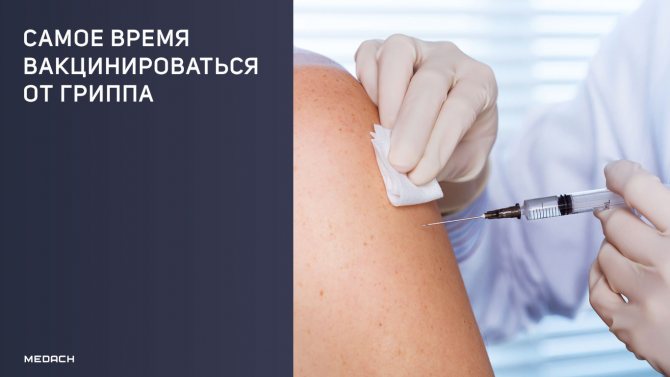
While the world is focused on the COVID-19 pandemic, we should not forget that every winter comes flu season, with viruses spreading especially quickly at this time of year. Their maximum activity occurs in December and January. If you get vaccinated now, you can reduce your chances of getting the flu.
Influenza is a serious illness caused by viruses that can require hospitalization and even lead to death. Each flu season is different, and the health impact of the virus varies from year to year, with some seasons being worse than others. Your best protection is to get vaccinated, which helps prevent the flu itself and its potential complications.
Vaccines that are recommended by the US Food and Drug Administration (FDA) definitely have a positive effect. According to the Centers for Disease Control and Prevention (CDC), during the 2018-19 flu season. Vaccination prevented 4.4 million influenza illnesses and 3,500 influenza-related deaths.
It is likely that influenza viruses and SARS-CoV-2 will circulate together this winter. There are FDA-approved vaccines to prevent influenza, so getting vaccinated can help you avoid doctor visits and conserve healthcare resources for patients with other illnesses, including COVID-19.
Each flu season, the FDA plays a key role in ensuring the availability of effective and safe vaccines. Influenza viruses are spread through droplets that infected people spread when they cough, sneeze and talk. The flu can also be transmitted through contact with objects on the surface of which there are viruses, as the person subsequently touches the mouth, nose and eyes with the same hand.
During flu season, it is better to get vaccinated early. The CDC recommends that adults and children over the age of six receive the vaccine by the end of October, but vaccinations may continue even after this date. It is no less beneficial because it will provide you with protection for the remainder of the flu season. For more information regarding vaccinations, vaccines and where to get them, we recommend visiting vaccines.gov.
Even if you have already had the flu without being vaccinated, the vaccine is also recommended because it contains three or four strains of the virus (depending on which vaccine you choose). If you have previously been infected with one flu virus, the vaccine will protect against strains you have not yet encountered.
The course of the flu season and its severity are unpredictable. An annual flu vaccine is the best preventative measure for people six months of age and older.
It is worth remembering that an annual flu vaccination is a way to protect other people from becoming infected. The more people are vaccinated, the less likely it is that the virus will spread widely in society.
Typically, vaccines change annually and contain the strains of viruses expected in the next flu season. The effectiveness of the influenza vaccine depends on many factors, such as the age, health of the recipient, the type of influenza virus circulating, and the level of similarity between the circulating virus and those viruses included in the vaccine.
The work to create a vaccine for the new flu season may have come to an end, but for the FDA the effort continues year-round.
The flu vaccine can stimulate your immune system to produce antibodies that can prevent illness. It takes two weeks for antibodies to develop after vaccination, so you should get vaccinated early, before the flu season begins.
According to the FDA's Office of Vaccine Research and Review, there are several reasons to support the development of new influenza vaccines every year.
Influenza viruses change every year, so vaccines must be updated to reflect what strains are expected in the new season. The vaccine must include strains of viruses that most closely match those currently circulating. The degree of protection from the influenza vaccine that was administered to the recipient in the previous season decreases over time and becomes so weak that it cannot prevent influenza in the next season.
Children and older people are usually most at risk of getting the flu. The best way to protect children who are too young to be vaccinated against disease is to make sure those around the child are vaccinated.
There is a possibility that the flu virus that circulates this season will begin to disproportionately affect young and older people.
Other methods to reduce the spread of influenza include routine measures such as hand washing, covering your mouth and nose when coughing and sneezing, and self-isolating if you feel sick.
The FDA has approved many vaccine options to prevent influenza. However, if you are already sick, the FDA recommends prescription antivirals. These medications work best if they are used as soon as symptoms appear (within the first 48 hours).
Every February (before the end of the flu season), the FDA and the World Health Organization (WHO), as well as experts from other public organizations, work together to collect and analyze data to predict the strain of virus that will cause more illness in the following season.
Following this process, the FDA convenes its Vaccine Advisory Committee of outside experts to create recommendations for the upcoming flu season.
Committee members discuss WHO recommendations and express opinions about which viruses are expected to circulate in the United States. They are also looking at data on which influenza viruses caused illness last year, virus variability, and disease trends across the country.
The FDA takes this information into account when selecting virus strains that it then recommends to licensed factories for inclusion in vaccines that will then be used in the United States.
The more similar the viruses selected for vaccines are to the viruses circulating this season, the more protection such vaccines provide. Even if a complete match is not achieved, this does not render the vaccine useless. Previous studies have shown that such vaccines make the disease easier and prevent dangerous complications associated with influenza.
To ensure that the influenza vaccine is safe, effective, and of high quality, the FDA makes and provides manufacturers with the reagents (vaccine standardization materials) needed to create the drug. The FDA annually inspects manufacturing facilities and reviews each vaccine made before recommending it.
FDA oversight doesn't end there. After manufacturers distribute their vaccines for general use, FDA and CDC scientists review reports submitted by companies, healthcare providers, and patients to the Vaccine Adverse Event Reporting System (VAERS).
Some additional methods are also used to monitor vaccine safety. For example, the Sentinel Post Licensure (PRISM) System allows the FDA to proactively evaluate vaccine safety in real-world patient care settings in the United States.
CDC also maintains a Vaccine Safety Datalink (VSD), which provides near real-time monitoring of vaccinated people; this occurs in collaboration with nine integrated health organizations.
Are flu vaccines safe for pregnant women?
Yes. Research shows that flu vaccines are safe for women at any stage of pregnancy.
There are several reasons why it is important for pregnant women to get a flu shot.
Pregnant women with influenza tend to have a more severe course of the disease and are at increased risk of complications and hospitalization.
In addition, getting a flu vaccine during pregnancy helps protect your baby from influenza during the first six months of life, when the baby is too young to receive the flu shot. The mother passes on this protection to her newborn child.
Take an injection and sleep well
Initially, the free flu vaccination program extended only to risk groups - children, the elderly, chronically ill people, pregnant women, as well as representatives of certain professions actively in contact with the population - doctors, teachers, housing and communal services workers. But since 2006, when influenza prevention was included in the National Vaccination Calendar, annual vaccination began to cover more and more people, becoming, in fact, universal. Now anyone can come to the clinic and get a free vaccination. Last year, 67.4 million people received prevention, 2.5 times more than at the start of the program, that is, 40 percent of the country’s population. This year, by the beginning of November, there were already more than 50 million, Rospotrebnadzor reported.
Vaccination coverage is important: the more people can resist infection, the lower the likelihood that a seasonal increase in incidence will turn into an epidemic
The effect, epidemiologists say, is obvious. “Over 11 years, thanks to a consistent increase in vaccination coverage to a level exceeding 40 percent of the country’s population, the incidence of influenza has decreased by more than 10 times - from 355 to 34.9 people per 100,000 population,” the ministry cites these statistics.
Of course, no one is “forcing” people to take an anti-flu injection, although more and more experts are talking about people’s responsibility for their own health and the health of others and the need to explain the harm of “anti-vaccination” sentiments. Therefore, doctors strongly recommend vaccination and explain that vaccination is the only reliable option to protect yourself from infection, which is fraught with all sorts of serious complications. Nevertheless, whether to vaccinate or not is up to everyone to decide for themselves.
This epidemic season, 62.3 million doses of vaccine were purchased for the regions at the expense of the federal budget, and the regions have already received more than half of this volume. Another 8-9 million people, according to statistics, are vaccinated on their own - at enterprises, through regional programs, in private clinics. This year there are already 5.6 million people of this kind. This means that there is a real chance that this season it will be possible to protect almost half of the country’s population. Coverage is important—the more people who can resist infection, the less likely it is that a seasonal surge in cases will reach epidemic levels.
The drugs used as part of the vaccination program are ours, domestic, and, according to experts, they are not inferior in quality and safety to foreign vaccines. Moreover, we also have our own unique developments. Thus, one of the vaccines contains a special substance - an immunoadjuvant, which ensures high effectiveness of the drug at a reduced concentration of the active ingredient and contributes to the development of stable immunity. And this year, Russia registered its own quadrivalent vaccine for the first time. It protects not from three, but from four types of influenza virus. Such ultra-modern vaccines, besides our country, are produced only in Australia, the USA, Canada, Germany and France.
“The import substitution policy implemented in the pharmaceutical industry is aimed at increasing the share of domestic drugs in government procurement. If we talk about the production of influenza vaccines, then to date in this direction we can state 100% achievement of the program’s goals - Russian industry is not only able to fully satisfy the state’s needs, but also increase the volume of supplies for the commercial segment,” says Minister of Health Veronika Skvortsova .
What are the side effects?
Mild side effects from the flu include soreness, redness or swelling at the injection site, mild fever and pain. Only about 1-2% of people who get a flu shot will have a fever.
Rare but serious side effects, including allergic reactions, may occur. Symptoms of serious side effects include difficulty breathing, swelling around the eyes or lips, hives, fast heartbeat, dizziness, and fever. If you experience serious side effects, you should get medical help right away, the CDC says.
For children, side effects from nasal spray may include runny nose, wheezing, headache, vomiting, muscle pain and fever. For adults, side effects include runny nose, headache, sore throat and cough. These side effects only last a short time compared to the real flu.
Can you get the flu after getting vaccinated?
It is a myth that you can get the flu from the flu vaccine.
The viruses are killed in it, so people cannot get sick. However, because people need to build up their immunity after vaccination, some people may become infected with the flu soon after their vaccination if they become infected with the flu during that time period.
Some people may also mistakenly attribute cold symptoms to the vaccine.
The nasal aerosol vaccine contains a “live attenuated” influenza virus, but the virus is weakened so that it cannot cause the flu. The viruses in the nasal spray cannot multiply in the temperatures of the lungs and other parts of the body. However, since the temperature in the nose is lower, the virus causes a small infection in it. This infection causes no symptoms in most people, but in some people it causes symptoms such as a runny nose and sore throat.
This local infection will prompt the body to produce antibodies against the influenza virus. This provides better protection against the real flu, which, of course, is a virus that can seriously bother you.
Who shouldn't get a flu shot?
Children younger than 6 months should not get a flu shot. Those who have had a serious allergic reaction to a flu vaccine in the past generally do not get vaccinated.
You should not get the flu vaccine if you have a fever. (You should wait until the fever goes away.)
However, if you have a minor illness, such as a minor cold or headache, you can still get a flu shot. The vaccine works great for this.
Flu vaccinations in Russia have become more popular in 2021
As a survey conducted by Vademecum together with the research company Fastuna showed, this year the number of Russians intending to get vaccinated against the flu has increased compared to previous epidemic seasons. If only 25% of respondents admitted to regular vaccination, then when asked whether they were going to get vaccinated this year, 37% of respondents answered affirmatively. Participants in the third session of the online discussion held by Vademecum with the support of Nacimbio on September 3 spoke about how the COVID-19 pandemic has affected the population’s attitude towards vaccination.
Fastuna surveyed 200 Russian residents aged 18 to 60 years. The majority - 60% - of respondents have never been vaccinated against the flu (according to Rospotrebnadzor, in 2021, vaccination coverage throughout Russia amounted to 50% of the country's population), but this year only 41% of respondents said they refused vaccination.
The majority of opponents of vaccination are among young people: only 5% of respondents aged 18 to 24 years agree to get vaccinated against the flu this year, while 10% are regularly vaccinated. Men are more willing to get vaccinated than women: 44% of men and 30% of women are planning to get vaccinated this year.
It also turned out that 50% of respondents trust flu vaccinations, while 35% of respondents noted that they trust vaccines less than before.
The opinions of those surveyed were also divided regarding the prospects for immunoprophylaxis of the new coronavirus infection. Developed by the Research Center of Epidemiology and Microbiology named after. N.F. The Gamaleya vaccine has already been introduced into civilian circulation, and vaccination of volunteers has begun. According to the survey, 45% of respondents are inclined not to get this vaccine, and 35% were “in favor” or “rather in favor” of vaccination.
The results of the Fastuna survey at the last online discussion “Vaccinations as a first necessity: how the pandemic has changed the attitude of Russians towards vaccination of children” were discussed by the head of the laboratory of vaccine prevention and immunotherapy of allergic diseases at the Research Institute of Vaccines and Serums named after. I.I. Mechnikov RAMS Mikhail Kostinov, chief therapist of the Fomin Clinic Daniil Serebryakov and scientific adviser to the Nacimbio holding of the Rostec state corporation, head of the department of hospital therapy No. 2 of the medical faculty of the Russian National Research Medical University named after. N.I. Pirogova Igor Nikitin. The discussion was moderated by an expert from the ONF, Chairman of the Council of Mothers of Russia, President of the Association of Consumers and Manufacturers of Children's Products and Tatyana Butskaya.
Has flu vaccination become more relevant in the context of the COVID-19 pandemic? In any case, the flu vaccine activates the immune system, and the receptors of the cells of the immune system launch the processes of resisting the virus earlier, Mikhail Kostinov is convinced.
Igor Nikitin agrees with his colleague: recently published scientific works prove that influenza vaccination stimulates immune mechanisms, increases the body’s ability to be alert, and helps it cope with other infectious diseases. At the treatment and rehabilitation center (TRC) of the Russian Ministry of Health, which is headed by an expert, mandatory flu vaccination is written into the employment contract. In 2021, 94% of LRC employees were vaccinated, not a single one of them got sick, and in addition, the medical institution recorded one of the lowest rates of cases of infection with a new coronavirus infection among health workers involved in the fight against COVID-19.
More than half – 59% – of Fastuna survey participants said they would like to know more about flu vaccination, while 19% of respondents had not heard anything about this year’s vaccination campaign before taking the survey. Education and promotion of immunoprophylaxis do not reach the young audience; there is not enough information about vaccination, told in simple scientific language, emphasized Daniil Serebryakov. “There is a lot of information about the upcoming vaccination on federal channels and radio. And where young people spend their leisure time - YouTube, bloggers - there is nothing sensible except subjective opinions, jokes and Internet memes. Therefore, there are those who have not decided on their position: this audience does not have an opinion leader. Please make me a science-fiction video that will tell you about the vaccine and how it affects our immunity,” the expert urged. – This way I can reach young people and tell them simply about difficult things. People want shorter, more concise information.”
Nevertheless, the demand for vaccination is growing, noted Igor Nikitin: “Last year, to immunize Russians, Nacimbio supplied 65 million doses of influenza vaccine to 85 regions, and in 2021 there will be more than 70 million doses. The need is calculated by the state based on the planned level of vaccination coverage for a particular year. This season it is planned to vaccinate at least 60% of the population.”
This is the third webinar in the series “New Immunity: How the Pandemic Will Change Approaches to Vaccine Prevention in Russia.” The first online discussion took place on August 18 and was dedicated to global experience and local initiatives to combat epidemics, including COVID-19. A week later, on August 25, a second meeting was held to discuss the specifics of the influenza vaccination campaign during the pandemic, the reality of the threat of a second wave of COVID-19, the possible impact of the combined circulation of viruses on human health, as well as the consequences of early influenza vaccination and increased work on immunoprophylaxis.
Source Vademecum
Subscribe to our channel in Telegram Subscribe to our channel in Yandex Zen
Share on social networks
+1 +1 +1 +1




